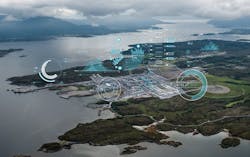Nyhamna gas plant’s digital twin boosts efficiency at zero net cost
Shane McArdle
Kongeberg Digital
Oslo, Norway
In late 2019, AS Norske Shell hired Kongsberg Gruppen ASA subsidiary Kongsberg Digital AS (KDI) to digitalize the Gassco AS-operated Nyhamna natural gas processing plant and export hub in Aukura municipality, Møre og Romsdal County, on Norway’s northwestern coast.
KDI partnered with Norske Shell—Nyhamna’s technical service provider (TSP)—to develop the Kongsberg digital twin, or Kongitwin, into a dynamic virtual representation of the gas plant and its real-time behavior. By design, the Nyhamna Dynamic Digital Twin (DDT) was to capture, integrate, and provide insight into operational data that users could leverage to further improve the plant’s productivity, reliability, and efficiency.
Implemented in early 2020 and continuously updated following rollout, the Nyhamna DDT identified opportunities during its first year of operation that enabled the gas plant to reduce operating costs by more than the total capital investment required for the digitalization initiative.
Plant overview
Commissioned in 2007, the Nyhamna plant was initially built as a hub for processing and exporting gas and condensate it received via two 30-in. pipelines from the Norske Shell-operated Ormen Lange deepwater field in 800-1,100 m of water on the Norwegian continental shelf, about 120 km northwest of Kristiansund, Norway. With an original nameplate processing capacity of 70 million cu m/day, the plant was upgraded in 2013-17 to begin receiving additional gas from Equinor ASA-operated Aasta Hansteen and surrounding fields in the Norwegian Sea’s Vøring basin delivered to the Nyhamna terminal by the 482-km Polarled pipeline (OGJ, July 1, 2019, p. 56).
At its expanded capacity of 84 million cu m/day, the Nyhamna onshore plant features a series of complex processing installations for liquids separation, dehydration, purification, and compression of gas that, post-treatment, is exported along the 1,300-m Langeled pipeline to the UK and continental Europe (Fig. 1).
Alongside associated installations for recycling antifreeze (used to prevent ice formation in pipes), water treatment, flaring, and liquids storage, the Nyhamna site also houses a marine terminal to accommodate export of condensate production to refineries around the world via tanker.
Digitalization journey
The oil and gas industry has long recognized the value of digital technologies in helping transform approaches to solving fundamental business problems. Adoption has been patchy, but there are examples of digital excellence in the industry within disciplines such as reservoir and flow assurance modelling. Major opportunities, however, still exist in employing digital technologies to enable better integration across disciplines, asset organizations, and participants throughout the value chain.
One digital technology with which the industry has grappled is the digital twin. KDI’s digital twin model targets full virtualization of a plant, describing its current state and ability based on the asset’s unique behavior in its specific environment, including aspects beyond the plant itself. By combining the collected data with visualization, modelling, and analytics, the twin becomes a rich framework to describe the plant’s current operational situation and predict how the asset will behave in the future.
The Kongitwin, in this sense, is alive, reflecting the asset’s behavior in real-time and integrating that real-time data describing the plant’s action and simulation capabilities with the total information architecture surrounding the asset. This includes collecting, contextualizing, and integrating plant-specific 2D engineering data (e.g., different diagrams and drawings engineers use to interact with the asset) into the twin to ensure an asset’s entire operations—as designed and in reality—are represented in the current state.
Recognizing that quality and structured data is a key enabler for leaner workflows and stronger analysis to support faster and better operational and business decisions, Norske Shell—together with Gassco and the Nyhamna and Ormen Lange partners—joined forces in October 2019 with Kongsberg Digital to develop the Nyhamna DDT.
Collaborative development, implementation
From the outset, Norske Shell outlined three primary goals to guide creation of the Nyhamna DDT, all of which were based on finding new and better solutions to drive improved business outcomes for the plant.
A core objective involved improving efficiency and accuracy of work processes related to maintenance, upgrading, and construction activities at the site. Carrying out even a single task typically requires different members of different teams coordinating equipment, tools, and various schematic drawings for a project, as well as ensuring those materials are where they need to be and when. Given the size of Nyhamna’s operations, the digital twin ideally would find a way to streamline the time and difficulty of completing these preliminary activities to allow increased focus on the more value-creating elements of a project.
A second imperative was to improve management of the plant’s power consumption. As Nyhamna receives power from the grid under Norwegian regulations, the plant must nominate in advance how much energy it will consume on both a daily and weekly basis. If the plant nominates more than it ultimately uses, it must then pay a fine. If it undernominates and requires additional electricity, it must pay a premium price for it.
A final goal of the Nyhamna partnership was to optimize processing activities to increase overall production. As Nyhamna relies on operating with very high availability and uptime, the DDT would need to help reduce potential downtime as well as enable production gains.
With Norske Shell’s objectives defined and recognizing a crucial component in any digital transformation is getting the workforce involved, KDI focused on establishing the Nyhamna DDT as a tool that would enable users to perform higher-value tasks with greater precision. The approach required maintaining close cooperation with the end users who knew the unique pain points of their daily work routines.
Rather than trying to convince end users of how cutting-edge the DDT technology was, KDI sought to develop features that provided the Nyhamna workforce with actionable insights to eliminate wasted time and improve their workdays. This approach required a collaborative process with a two-way flow of information between KDI and Norske Shell teams that allowed maximum use of vital domain knowledge in developing solutions to meet the site’s specific needs.
Based on extensive knowledge and information exchange, Kongsberg and Norske Shell—in less than 100 days—developed the Nyhamna DDT, which went live in January 2020 to an initial group of 100 users primarily from the plant’s maintenance and operations support teams. First-year focus centered on embedding work processes into the twin’s ecosystem, as well as developing and implementing machine-learning applications used for prediction and optimization.
Developing digital work processes
An initial challenge in developing the plant’s DDT was harmonizing all necessary data to ensure every user had access to the same, updated data and could simultaneously collaborate in a singular environment based on identical, real-time information. After a series of ongoing shared discussions and cooperation between Nyhamna and KDI teams to establish data requirements and procedures, the DDT was able to present a single platform integrating data from all plant systems and make that data available to Nyhamna staff across different divisions—as well as to suppliers and contractors—via desktop and mobile devices.
Alongside improving collaboration with contractors and between Nyhama’s own internal divisions, access to this single, real-time view has reduced the time and frequency required for physical site visits. By recovering time previously devoted to nonessential tasks such as retrieving and delivering drawings and equipment from and to various locations around the plant, Nyhamna’s workforce can dedicate that time to the more intelligent, operations-focused tasks.
While Norske Shell’s work processes at Nyhamna follow parent company Royal Dutch Shell PLC’s global guidelines, these processes were developed for the analog world. The Nyhamna DDT, however, has created the opportunity for personnel to adapt and conform to those analog-based guidelines in a digitized world. One specific example involves the maintenance work permit process.
Every type of on-site maintenance work carried out in the plant requires a work permit, the requirements for which are governed by strict rules and regulations in Norway as well as general standards implemented across the global oil and gas industry. To improve this process, the Nyhamna DDT incorporated the capability to consolidate visualization of all work permits and types of risk posed into one cumulative 3D visual. The shift from viewing these items individually on lists on screen in SAP to having them combined in a 3D visual has expedited and improved the risk-based discussion, transforming how staff interact with and execute projects to ensure maximum safety.
While the work permitting process requirements remain the same, the way and speed with which users can identify and focus on associated risk elements has changed. With just a few keystrokes, plant personnel are now able to easily navigate all as-built 2D documentation by tag search within the comprehensive 3D model. With the mobile version of the DDT, for example, process technicians are at any time and place able to access the 3D model showing real-time pressure, temperature, and flow on different plant systems directly on their smart devices, eliminating the need for colleagues in the control room to provide them with that data (Fig. 2).
Alongside increasing efficiency and safety of the work preparation process, on-site access to the 3D model has simplified cross-team communications, reduced the number of required meetings, expedited location of equipment like valves and detectors, reduced data crosschecks between applications, and lessened time and intraplant travel previously spent on field inspections.
Another capability integrated into the Nyhamna DTT includes applications for optimizing plant processing activities over a longer-term period compared with a previous optimization strategy focused on daily operations. This involved connecting a process simulator already used at Nyhamna with different user interfaces built into the DTT. The added user interfaces gave engineers access to additional variables around the plant pertinent to the production process.
The DTT’s combination of process simulator and user interfaces has enabled engineers to explore the plant’s operational framework under a variety of scenarios by running what-if simulations, the results of which allow engineering and control room teams to make more accurate decisions—based on plant-wide information—about process changes for achieving optimal plant configuration (Fig. 3).
Results
Since its early-2020 commissioning, the Nyhamna DDT has maintained steady operation, continuously evolving via monthly product releases focused on boosting production rates and improving the plant’s use of energy.
During the first year of use, Norske Shell and KDI teams were able to develop use cases with the Nyhamna DDT that, by providing a full line of sight to plant operations, enabled the TSP to reduce the plant’s operating costs by about $3 million, more than the actual cost of the twin.
First-year cost savings specifically supported by the DDT resulted from work process improvements, reduced IT costs, increased efficiencies in execution of maintenance-upgrading-construction activities, and optimized energy consumption.
Now in use by divisions across the plant, the Nyhamna DDT capabilities help plant maintenance and operations support teams with engineering documentation, real-time data on specific equipment, and collating disparate data sources back into the SAP system. Nyhamna’s teams also have continued to develop how data are made available to them, benefitting user groups throughout the plant that previously had to gather information from up to a dozen different systems daily.
Expanding the twin
With the Nyhamna project paving the way, Norske Shell is now working with KDI to deploy the DDT model to Ormen Lange field, which Norske Shell operates on behalf of field partners.
Designed to maximize recovery, optimize the production process, and reduce the operational environmental footprint, the Ormen Lange DTT—which will include all offshore infrastructure—will feed into the Nyhamna twin to become the first reservoir-to-market twin, enabling Norske Shell a complete, unified view of project operations from the reservoir, through wells, pipelines, and into the onshore processing plant.
Since Norway is allowing the Norske Shell-KDI partnership to develop the offshore DDT to generate value from all subscribing assets, the partnership will share what works for Ormen Lange for implementation at other subsea assets as they mature.
The author
Shane McArdle ([email protected]) is senior vice-president of digital energy at Kongeberg Digital, where he specializes in helping organizations in the oil and gas, new energy, and maritime sectors adopt new technologies and services to equip their businesses to move into the digitalized future. He holds a BS (2001) in clean technology, industrial chemistry, and environmental impact as well as a PhD (2007) in chemical engineering, both from the University of Limerick, Ireland.



